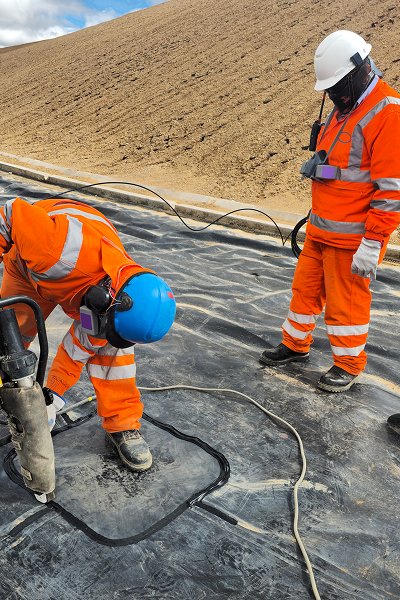What is gram weight ?
GSM (grams per square meter) is an important indicator to measure the quality of non-woven geotextiles per unit area, indicating the weight of geotextiles per square meter. For example:
100g/m² means 100 grams per square meter;
600g/m² means 600 grams per square meter.


Why weight selection is important
Determine the structural strength of the material
The tensile strength, bursting strength and puncture resistance of non-woven geotextiles increase with the increase of gram weight. Especially in high stress environments, such as:
Roadbed compaction construction;
High landfill loading;
Rough contact surface of dam or reservoir protective layer;
Impact on drainage and filtration performance
Low-weight (such as 100g/m²) geotextiles have large porosity and strong water permeability, and are suitable for environments that require rapid water penetration, such as gardening, drainage ditches, and green belts.
However, if low-weight products are still used in the filter layer of highway slopes, it is easy to cause fine soil particles to penetrate and block, thus forming "anti-filtration failure" and causing slope sliding.
On the contrary, too high a weight will reduce the porosity, causing poor water flow, and even cause seepage pressure accumulation, affecting structural stability.
There is a strict matching relationship for different types of projects
Different engineering scenarios have completely different requirements for geotextile performance. Choosing the wrong weight may directly lead to:
Leakage, soft foundation subsidence: if the weight does not meet the standard, the filter layer will fail;
Insufficient protection: such as the dam body landslide caused by the puncture of the fabric layer;
Waste: such as the use of high-weight materials in light-load greening projects.
Basic Structure of Nonwoven Geotextiles
| Structural Parameter | Description |
|---|---|
| Fiber orientation | Random and multidirectional distribution without warp/weft |
| Pore structure | High porosity and uniform voids for good permeability |
| Surface texture | Soft and fuzzy, increasing soil-geotextile friction |
| Layer configuration | Typically single-layer, but can be laminated with membranes or reinforcement layers |
Classification by Function
| Type | Main Function | Typical Weight Range |
|---|---|---|
| Filtration | Prevent soil loss while allowing water flow | 100–250g/m² |
| Separation | Prevent mixing of different soil layers | 150–300g/m² |
| Drainage | Channel water along planes or surfaces | 200–350g/m² |
| Reinforcement | Improve subgrade strength and stability | 300–500g/m² |
| Protection | Cushion underlying layers (e.g., geomembranes) | 400–600g/m² |
Key factors to consider when choosing grammage
Foundation soil conditions and pressure-bearing grade
Loose soil/stoney soil: Thicker and heavier geotextiles should be used to prevent perforation;
Weak foundation: It is recommended to use high-weight and high-strength geotextiles for stress dispersion and reinforcement;
Good sandy soil/clay foundation: Medium-weight products can be used appropriately to take into account economy.
Service life and durability requirements
Short-term projects (such as temporary road construction, landfill cover, etc.):
Low weight (100-250g/m²) can be selected, which is low cost and flexible to lay;
Long-term structures (such as permanent dams, reservoirs, landfills):
It is recommended to use high weight (350g/m² or more) to ensure long-term strength and corrosion resistance.
Coordination with other materials
With geomembrane:
Geotextile is often used as a protective layer for geomembrane. At this time, it is recommended that the weight should be ≥400g/m² to improve the buffering and puncture resistance.
With drainage board and blind ditch:
It needs to have high water permeability and filtration accuracy, and the weight should be 200~300g/m².
FAQ
Q1: Does the higher the weight, the better the quality of the geotextile?
A:Not necessarily. Although a higher weight usually means thicker and stronger physical properties, it does not mean that it is the most suitable choice in all application scenarios. For example, in simple filtration or temporary construction scenarios, the use of high-weight geotextiles above 400g/m² will cause resource waste and increase costs. Therefore, the most appropriate weight should be selected according to the engineering purpose and design requirements, rather than blindly pursuing high weight.
Q2: Can the weight of geotextiles be used as the only purchasing indicator?
A:No. In addition to weight, key technical indicators such as tensile strength, CBR bursting strength, pore size, water permeability, and UV resistance should also be referred to. Two products of the same weight may have very different actual performance if the manufacturing process and material quality are different. Therefore, the product quality report or third-party test data should be comprehensively examined when purchasing.
Q3: Can 100g/m² non-woven geotextiles be used for drainage layers?
A:Generally not recommended. Geotextiles with a weight of 100g/m² have good water permeability, but weak pressure resistance and puncture resistance. They are easily crushed or blocked by upper materials under the drainage layer, affecting the long-term drainage effect. Usually, geotextiles with drainage functions should be selected at 200~350g/m² to balance water permeability and structural strength.
Q4: Is lightweight geotextile (<150g/m²) reliable in engineering?
A:In some light-load or temporary uses (such as greening base isolation, temporary construction road stratification), lightweight geotextiles are an economical and reliable choice. However, in projects with high pressure and long service life, lightweight geotextiles have risks such as puncture damage, subsidence and blockage, and should be used with caution.
Q5: Is it normal for products with similar weights to have large price differences?
Answer:
Normal. The factors that affect the price are not only the weight, but also:
Material composition (recycled materials vs. virgin materials);
Manufacturing process (needle density, fiber strength);
Product certification (whether there is CE, ISO, national standard test report);
Brand reputation and after-sales service guarantee.


